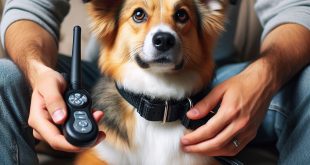Training A Dog To Walk On A Leash – Throughout the ages, dogs have been known as man’s best friend. They are loyal, loving, and always there when we need them. But, just like any other friend, they need to be taught certain things so that they can be a great companion. One of the most important things that you can teach your dog is how to walk on a leash. This can be a daunting task, especially for first-time pet owners. However, by following a few simple tips and tricks, you can train your furry best friend to walk nicely on a lead and make walks enjoyable occasions for both of you. In this article, we will explore the techniques and approaches that you can use when training your dog to walk on a leash. Let’s take a look.
Table of Contents
1. Turning canine chaos into walking wonder: the ins and outs of leash training
Leash training can turn your dog from a chaotic mess into a well-behaved walking companion. But where do you begin? Start by selecting the right leash and collar for your dog’s size and training needs. A flat collar is suitable for most dogs, but a martingale collar may be a better fit for dogs who tend to slip out of their collars.
Once you have the proper equipment, begin by introducing your dog to the leash indoors. Let them sniff and explore the leash, rewarding calm behavior with treats. Gradually work up to attaching the leash to the collar, and then move outdoors.
When walking your dog on a leash, keep them close to you and use verbal commands to encourage them to follow your lead. A tight leash indicates tension and may signal to your dog that there is a threat nearby. Keep the leash loose and adjust it as needed. Encourage good behavior with positive reinforcement, and correct unwanted behavior with a firm but gentle tug on the leash.
Remember, leash training takes time, patience, and consistency. With practice and positive reinforcement, you can turn your canine chaos into walking wonder.
2. Put your paw forward: a step-by-step guide to teaching your furry friend to walk on a leash
Getting your furry friend to walk on a leash can be a daunting task but it is an essential skill that every dog must learn. Here is a guide to help you teach your dog to walk on a leash with ease.
First, introduce your dog to their leash and collar. Give them time to sniff and become comfortable with the new gear. Once they are comfortable, attach the leash to their collar and let them drag it around the house. This will help them get used to the sensation of being restrained.
Next, choose a comfortable harness that your dog will wear during their walks. Clip the leash to the harness and let your dog explore their surroundings with it on. Before you begin walking, make sure that the harness fits properly and is not too tight or too loose.
Start slowly by walking your dog around your yard or a quiet area where there are few distractions. Encourage them to walk by your side using treats and verbal cues. If your dog pulls on the leash, stop walking and wait for them to calm down. Gradually increase the distance and duration of your walks and reward your dog for good behavior. With patience and consistency, your furry friend will be walking on a leash like a pro in no time!
3. Unleashing the power of positive reinforcement: reward-based techniques for successful leash training
Positive reinforcement is a highly effective approach for leash training dogs. This method involves rewarding your furry friend for good behavior, which encourages them to repeat the same behavior in the future. While it may take some time and patience to get your dog accustomed to this technique, the results are well worth the effort. Here are some tips to help you use positive reinforcement for effective leash training:
• Use treats: When your pooch walks calmly by your side or doesn’t pull on their leash, give them a treat as a reward. This will reinforce the idea that good behavior is rewarded. Make sure that you choose treats that your dog loves and that are easy to carry.
• Give verbal praise: In addition to treats, give your furry friend plenty of verbal praise when they do well during leash training. Use a happy, upbeat tone to encourage them and reinforce good behavior.
• Be consistent: Consistency is key when it comes to positive reinforcement. Make sure that you reward your dog every time they do something right, whether it’s walking calmly by your side or waiting patiently at traffic lights.
With these reward-based techniques, you can train your dog to walk calmly on a leash and have a more enjoyable walking experience. Remember to be patient and consistent, and soon enough your furry friend will be a pro at leash training!
4. From tug-of-war to teamwork: how to build a better bond with your dog on walks
Walking your dog can be a great bonding experience, but for some dogs, it can be a battle of wills. A dog that pulls constantly, stops to sniff everything, and insists on going his own way can make the experience frustrating for both of you. Fortunately, there are ways to turn the tug-of-war into teamwork.
One important way to build a better bond with your dog on walks is to make the experience more interactive. Try playing games with your dog as you walk, such as hiding treats for him to find or playing fetch with a ball or Frisbee. This will keep your dog mentally and physically stimulated as well as more engaged with you. You can also try using a training tool, such as a clicker or treats, to reinforce good behavior as you walk.
Another way to improve your bond with your dog is to provide plenty of positive reinforcement. When your dog does something you like, such as walking calmly on a loose leash or coming when called, be sure to reward him with praise, treats, or affection. This will encourage your dog to repeat that behavior in the future. On the other hand, if your dog is pulling or showing other undesirable behaviors, try to redirect his attention and use positive reinforcement when he responds appropriately. With patience, consistency, and a little creativity, you can build a stronger and more enjoyable relationship with your furry friend on walks.
5. Walk this way: troubleshooting common challenges and tips for maintaining good leash manners
Leash manners are essential for dogs and their owners to have an enjoyable and safe walking experience. However, dogs can face common challenges that can affect their leash manners. Here are some tips on how to troubleshoot these challenges and maintain good leash manners.
1. Pulling on the Leash
One common challenge is when a dog pulls on their leash, causing discomfort for their owner. To address this issue, consider using a front-clip harness. This harness allows the leash to attach to the front of the dog’s chest, reducing their pulling power. Additionally, try walking at a slower pace and stop walking when the dog pulls. This helps the dog understand that pulling does not lead to moving forward.
2. Reactivity to Other Dogs
When dogs get excited or anxious around other dogs, it can lead to leash pulling and erratic behavior. In this case, consider using a head halter or a back-clip harness. These tools help prevent the dog from pulling and provide more control. Additionally, create distance from other dogs and reward your dog for remaining calm.
3. Biting the Leash
Some dogs may engage in destructive behaviors such as biting the leash. In this case, try distracting your dog with their favorite toy or treat. Also, avoid using retractable leashes as they can encourage leash biting. Instead, opt for a sturdy and durable leash that can withstand your dog’s chewing habits.
By troubleshooting these common challenges and consistently reinforcing good leash manners, owners can ensure their dog’s walking experience is safe and enjoyable.
Training your dog to walk on a leash is a rewarding experience and will benefit both of you in the long run. It’s also a great opportunity to build a stronger bond with your furry friend and provide them with mental enrichment, too. With plenty of patience and consistency, you and your pup will be walking the walk soon enough!
 Treat For Dog – Brain Training for Dogs, Dog Training & Obedience Discover Treat For Dog and get your pup on the path to smarter, happier, and healthier living with brain training for dogs.
Treat For Dog – Brain Training for Dogs, Dog Training & Obedience Discover Treat For Dog and get your pup on the path to smarter, happier, and healthier living with brain training for dogs.




